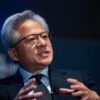Nvidia CEO Jensen Huang Visits Beijing Amid U.S. Chip Export Ban: Implications for AI and Global Tech Dynamics
In a move that highlights the growing friction between the U.S. and China over advanced technologies, Nvidia CEO Jensen Huang recently traveled to Beijing. This high-profile visit comes shortly after the U.S. government implemented restrictions preventing Nvidia from selling its AI chips to China. The decision is part of a broader effort by Washington to curb China’s access to cutting-edge artificial intelligence capabilities, citing concerns over national security. Huang’s trip underscores the complexities faced by tech giants navigating geopolitical tensions while striving to maintain critical business ties.
Understanding the Significance of the Visit
Jensen Huang’s arrival in Beijing has drawn significant attention due to the timing and context of his visit. The Trump administration’s recent export ban on Nvidia’s H20 AI chip has placed the company at the center of an escalating U.S.-China tech rivalry. By visiting Beijing, Huang signals Nvidia’s intent to address these challenges head-on. Industry experts believe he may have engaged in discussions aimed at identifying potential solutions, such as seeking exemptions or exploring alternative strategies to mitigate the impact of the ban. For a company as influential as Nvidia, maintaining strong ties with Chinese partners remains essential, despite the mounting regulatory hurdles.
The Broader Context: U.S.-China Semiconductor Rivalry
The U.S. has been intensifying its efforts to restrict semiconductor exports to China, driven by fears that advanced chips could bolster China’s military and AI capabilities. As a leader in AI hardware, Nvidia finds itself caught in the crossfire of this geopolitical tug-of-war. The export ban not only threatens Nvidia’s market share but also amplifies the uncertainty surrounding the global semiconductor supply chain. Huang’s visit reflects the delicate balancing act required by tech companies operating in this environment—complying with stringent U.S. regulations while preserving their foothold in one of the world’s largest markets.
Key Figures in the Ongoing Saga
Two central figures dominate this unfolding narrative. On one side is Jensen Huang, Nvidia’s visionary CEO, whose leadership has positioned the company as a powerhouse in AI and gaming hardware. On the other is the Trump administration, which has adopted an aggressive stance on limiting technology transfers to China. Its decision to impose export restrictions has created a challenging landscape for Nvidia, forcing the company to rethink its strategy in the region.
What Lies Ahead for Nvidia and Its Stakeholders?
The U.S. ban on Nvidia’s AI chips poses a significant challenge for Chinese tech firms reliant on these components for AI research and data center operations. For Nvidia, the stakes are equally high, as China accounts for nearly a quarter of its global revenue. Losing access to this critical market could lead to substantial financial setbacks and diminish the company’s influence in the AI sector. While Huang’s visit to Beijing may indicate ongoing negotiations, the broader U.S.-China tech conflict shows little sign of abating. This standoff has far-reaching implications, potentially disrupting the global tech supply chain and affecting industries ranging from AI startups to cloud computing giants.
Navigating the Complexities of Geopolitical Tensions in Tech
As the U.S. and China continue to vie for technological supremacy, companies like Nvidia face unprecedented challenges. Huang’s visit to Beijing serves as a reminder of the intricate web of relationships and interests at play. The ability to navigate these geopolitical tensions will determine not only Nvidia’s future but also the trajectory of the global AI landscape. Finding a middle ground between policy compliance and profitability remains a daunting task, particularly as both nations remain steadfast in their positions.
Final Observations
Jensen Huang’s visit to Beijing transcends a routine corporate meeting—it symbolizes the high-stakes battle for AI dominance. With the U.S. and China entrenched in a tech cold war, companies like Nvidia must tread carefully, balancing compliance with innovation. The outcome of this struggle will shape the future of AI and redefine the global balance of technological power. For now, all eyes remain on Nvidia as it seeks to preserve its role in one of the most dynamic yet contentious markets in the world.





























Comment Template